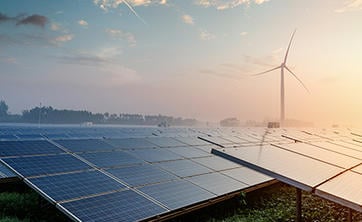Climate action in our operations

With food production accounting for around a third of all emissions, our sector has a vital role to play in helping to reduce the impacts of climate change.
While most of our emissions come from our agriculture supply chain, our efforts to reduce greenhouse gas emissions in our operations are also critical for reaching net zero.
Reducing emissions in our operations
Increasing our renewable energy capacity
Our actions toward net zero evolve as we identify opportunities. Some of those actions have already delivered immediate short-term benefits, such as increasing our purchases of renewable electricity.
In March 2023, we increased our renewables capacity with a significant investment in a major new solar energy project in Texas, North America. The 600 hectare solar project, owned and developed by Enel North America, will add 208 MW of solar electricity to the U.S. grid.
In addition to our direct investment, Nestlé will purchase 100% of the renewable electricity attributes generated by the project’s energy production for 15 years. The annual carbon emission reduction is expected to be equivalent to the emissions of more than 27 200 cars per year.
Maintaining carbon efficiency at our plants
We purchase capacity for our manufacturing facilities, via:
- Energy Attribute Certificates (including Renewable Energy Certificates (RECS), Guarantee of Origin (GoOs) and International RECs (IRECS), depending on location)
- Green tariffs
- Power Purchase Agreements (both on-site and off-site)
We continue building on existing actions, such as the rollout of responsibly sourced biomass boilers at several Nestlé factories and the implementation of energy-saving measures such as the installation of LED lighting and phasing out the use of harmful gases used in refrigeration.

Increasing our transport solutions
In our transport and logistics operations, we prioritize greenhouse gas emissions reductions, energy consumption and efficient warehousing. With our extensive footprint across many regions, we realize that there is no single solution. We work locally, deploying the interventions that we know can enable us to reach our interim 2025 20% reduction target; see examples below:
- Nestlé Chile has launched the largest fleet of liquid natural gas trucks in the country delivering a 20% reduction in CO2e emissions and eliminating 96% of solid particle emissions via 30 vehicles.
- Nestlé India has joined 14 other companies in the Zero Emission Vehicles Emerging Markets Initiative to advance the electrification of the truck market in India, expected to be 7 700 vehicles by 2030.
- Nestlé UK and Ireland have deployed double-stacked rail for a trial with a retailer which has the potential to take up to 76 heavy goods vehicles off the roads, with 76% less CO2e emissions than a diesel road journey.
- Nestlé Thailand piloted 100% electric-powered freight trucks in 2023 to deliver products from the company’s factories to its distribution centers and retail stores. This trial initiative is expected to reduce greenhouse gas emissions by approximately 104 tonnes per year per truck.
Using more renewable thermal energy
Our operations use renewable thermal energy as well as electricity. For example, in Indonesia and Malaysia, five factories have switched from fossil fuels to using locally supplied rice husk as a biofuel.
We have introduced industrial heat pumps, replacing the use of fossil fuels in La Penilla, Spain, saving 1 750 tonnes of CO2e, and in Konolfingen and Orbe in Switzerland, saving 1 000 tonnes of CO2e each per year.
Improving our emissions data
To ensure that our climate change mitigation approach is as effective as possible, we regularly refine our methodologies as new data points become available. This increased granularity is reflected in the emissions data we now request from our suppliers. Moving from estimated figures has affected our baseline, i.e., the number we measure against. As more primary data becomes available, we anticipate further revisions to our baseline, which may increase or decrease our overall footprint.

Combating climate change at our mealtimes
We feed our global workforce roughly 50 million meals every year through our on-site restaurants. Our restaurants have promoted lower environmental impact choices for many years, offering a range of plant-based and locally sourced options, along with information on the impact of the ingredients, making it easier for our employees to choose low-emission foods.












